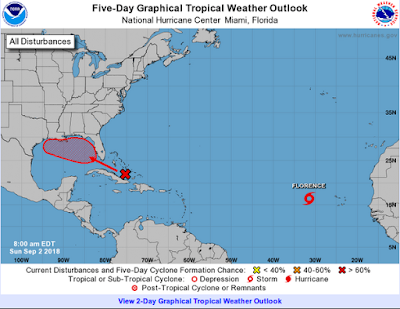#13,476
Although it isn't well defined, a tropical wave making its way north of the Greater Antilles is expected to intensify after is crosses the Florida Straits into the Gulf of Mexico in a couple of days.
This morning's Atlantic Tropical Outlook from the NHC reads:
Disorganized showers and thunderstorms over the southeastern and central Bahamas and adjacent Atlantic waters, including the Straits of Florida, are associated with a tropical wave interacting with an upper-level trough. This weather system is expected to move west-northwestward across the remainder of the Bahamas, southern Florida, and the Florida Keys during the next day or so and little, if any, development is expected during that time due to strong upper-level winds.
However, the current unfavorable upper-level wind pattern is expected to gradually change and become more conducive for a tropical depression to form over the eastern and central Gulf of Mexico by Tuesday or Wednesday. This disturbance will spread locally heavy rains across much of the Bahamas, southern Florida, and the Keys during the next day or two. See products from your local weather forecast office for more information.
* Formation chance through 48 hours...medium...50 percent.
* Formation chance through 5 days...high...80 percent.Even though the models don't ramp this up into a big storm, residents along the Gulf coast, from Florida to Texas, need to monitor the progress of this system, and be ready to activate their storm preparation plans should the need arise.
Even though it looks as if this system will pass me by (a relief, after last year's encounter with Irma), I'm reviewing my hurricane preparedness plans, and I'll be ready should the forecast change.
As a native Floridian, that wasn't my first tropical rodeo, which is why I prepare every year. And why I highlight National Hurricane Preparedness Week each May and National Preparedness Month every September.
Both are reminders that whether you live in Hurricane country, Tornado Alley, on a fault line, in the shadow of a volcano, or simply anywhere else on earth - a disaster (natural or otherwise) can occur.No matter where you live, you need to ask yourself . . . if a disaster struck my community today, do I already have?
- A battery operated NWS Emergency Radio to find out what was going on, and to get vital instructions from emergency officials
- A decent first-aid kit, so that you can treat injuries
- Enough non-perishable food and water on hand to feed and hydrate your family (including pets) for the duration
- A way to provide light when the grid is down.
- A way to cook safely without electricity
- A way to purify or filter water
- A way to stay cool (fans) or warm when the power is out.
- A small supply of cash to use in case credit/debit machines are not working
- An emergency plan, including meeting places, emergency out-of-state contact numbers, a disaster buddy, and in case you must evacuate, a bug-out bag and a predetermined place to go.
- Spare supply of essential prescription medicines that you or your family may need
- A way to entertain yourself, or your kids, during a prolonged blackout
Despite being pretty well prepared going into last year's hurricane season, I found some areas of my preps that needed tweaking (see Little Preps Mean A Lot and Rethinking Solar Power On A Budget), something I worked on over the winter.I hope you'll join me all this month as we explore more ways to prepare for the unexpected. Until then, you may wish to revisit:
When 72 Hours Isn’t Enough
In An Emergency, Who Has Your Back?
Tapping Into Your Preps
